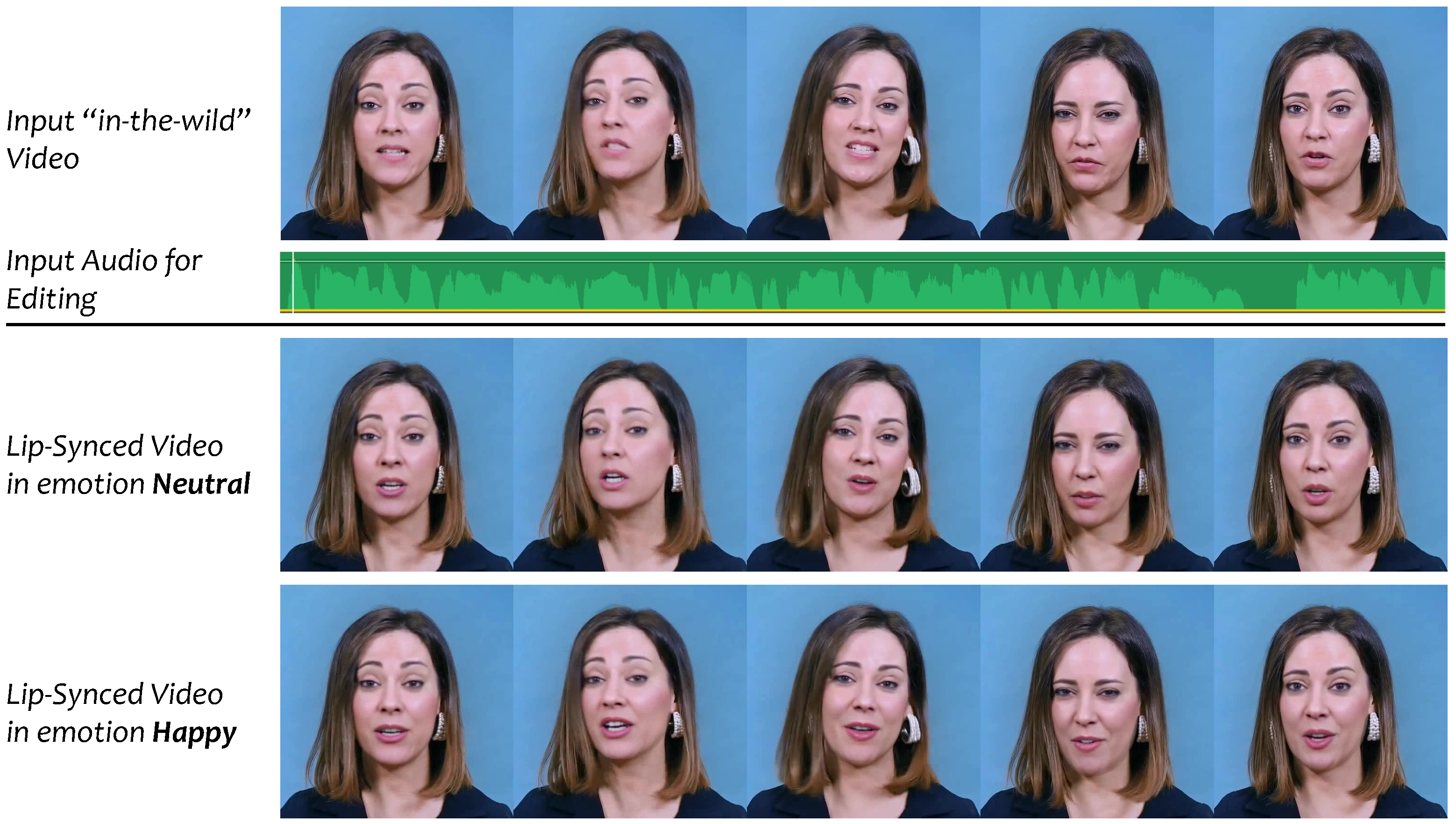sadtalker-video
Maintainer: gauravk95

1.7K
✅
| Property | Value |
|---|---|
| Run this model | Run on Replicate |
| API spec | View on Replicate |
| Github link | View on Github |
| Paper link | No paper link provided |
Create account to get full access
Model overview
The sadtalker-video model, developed by Gaurav Kohli, is a video lip synchronization model that can generate talking head videos from audio input. It builds upon the work of the SadTalker and VideoReTalking models, which focused on audio-driven single image and video talking face animation respectively.
Model inputs and outputs
The sadtalker-video model takes two inputs: an audio file (.wav or .mp4) and a source video file (.mp4). The model can then generate a synchronized talking head video, with the option to enhance the lip region or the entire face. Additionally, the model can use Depth-Aware Video Frame Interpolation (DAIN) to increase the frame rate of the output video, resulting in smoother transitions.
Inputs
- Audio Input Path: The path to the audio file (.wav or .mp4) that will drive the lip movements.
- Video Input Path: The path to the source video file (.mp4) that will be used as the base for the lip-synced output.
- Use DAIN: A boolean flag to enable or disable Depth-Aware Video Frame Interpolation, which can improve the smoothness of the output video.
- Enhancer Region: The area of the face to be enhanced, with options for "lip", "face", or "none".
Outputs
- Output: The path to the generated lip-synced video file.
Capabilities
The sadtalker-video model can generate realistic lip-synced talking head videos from audio and source video input. It offers several enhancements, such as the ability to focus the enhancement on the lip region or the entire face, and the option to use DAIN to improve the smoothness of the output.
What can I use it for?
The sadtalker-video model can be used for a variety of applications, such as video dubbing, virtual assistants, and animated videos. It can be particularly useful for creating personalized content, enhancing existing videos, or generating synthetic media for various use cases.
Things to try
One interesting aspect of the sadtalker-video model is the ability to selectively enhance different regions of the face. You could experiment with the different enhancement options to see how they affect the quality and realism of the generated videos. Additionally, trying out the DAIN feature can help you understand how it impacts the smoothness and transitions in the output.
This summary was produced with help from an AI and may contain inaccuracies - check out the links to read the original source documents!
Related Models
🛸
sadtalker

100
sadtalker is an AI model developed by researchers at Tencent AI Lab and Xi'an Jiaotong University that enables stylized audio-driven single image talking face animation. It extends the popular video-retalking model, which focuses on audio-based lip synchronization for talking head video editing. sadtalker takes this a step further by generating a 3D talking head animation from a single portrait image and an audio clip. Model inputs and outputs sadtalker takes two main inputs: a source image (which can be a still image or a short video) and an audio clip. The model then generates a talking head video that animates the person in the source image to match the audio. This can be used to create expressive, stylized talking head videos from just a single photo. Inputs Source Image**: The portrait image or short video that will be animated Driven Audio**: The audio clip that will drive the facial animation Outputs Talking Head Video**: An animated video of the person in the source image speaking in sync with the driven audio Capabilities sadtalker is capable of generating realistic 3D facial animations from a single portrait image and an audio clip. The animations capture natural head pose, eye blinks, and lip sync, resulting in a stylized talking head video. The model can handle a variety of facial expressions and is able to preserve the identity of the person in the source image. What can I use it for? sadtalker can be used to create custom talking head videos for a variety of applications, such as: Generating animated content for games, films, or virtual avatars Creating personalized videos for marketing, education, or entertainment Dubbing or re-voicing existing videos with new audio Animating portraits or headshots to add movement and expression The model's ability to work from a single image input makes it particularly useful for quickly creating talking head content without the need for complex 3D modeling or animation workflows. Things to try Some interesting things to experiment with using sadtalker include: Trying different source images, from portraits to more stylized or cartoon-like illustrations, to see how the model handles various artistic styles Combining sadtalker with other AI models like stable-diffusion to generate entirely new talking head characters Exploring the model's capabilities with different types of audio, such as singing, accents, or emotional speech Integrating sadtalker into larger video or animation pipelines to streamline content creation The versatility and ease of use of sadtalker make it a powerful tool for anyone looking to create expressive, personalized talking head videos.
Updated Invalid Date

sadtalker

17
sadtalker is a model for stylized audio-driven single image talking face animation, developed by researchers from Xi'an Jiaotong University, Tencent AI Lab, and Ant Group. It extends the capabilities of previous work on video-retalking and face-vid2vid by enabling high-quality talking head animation from a single portrait image and an audio input. Model inputs and outputs The sadtalker model takes in a single portrait image and an audio file as inputs, and generates a talking head video where the portrait image is animated to match the audio. The model can handle various types of audio and image inputs, including videos, WAV files, and PNG/JPG images. Inputs Source Image**: A single portrait image to be animated Driven Audio**: An audio file (.wav or .mp4) that will drive the animation of the portrait image Outputs Talking Head Video**: An MP4 video file containing the animated portrait image synchronized with the input audio Capabilities sadtalker can produce highly realistic and stylized talking head animations from a single portrait image and audio input. The model is capable of generating natural-looking facial expressions, lip movements, and head poses that closely match the input audio. It can handle a wide range of audio styles, from natural speech to singing, and can produce animations with different levels of stylization. What can I use it for? The sadtalker model can be used for a variety of applications, such as virtual assistants, video dubbing, content creation, and more. For example, you could use it to create animated talking avatars for your virtual assistant, or to dub videos in a different language while maintaining the original actor's facial expressions. The model's ability to generate stylized animations also makes it useful for creating engaging and visually appealing content for social media, advertisements, and creative projects. Things to try One interesting aspect of sadtalker is its ability to generate full-body animations from a single portrait image. By using the --still and --preprocess full options, you can create natural-looking full-body videos where the original image is seamlessly integrated into the animation. This can be useful for creating more immersive and engaging video content. Another feature to explore is the --enhancer gfpgan option, which can be used to improve the quality and realism of the generated videos by applying facial enhancement techniques. This can be particularly useful for improving the appearance of low-quality or noisy source images.
Updated Invalid Date

video-retalking

5.7K
The video-retalking model is a powerful AI system developed by Tencent AI Lab researchers that can edit the faces of real-world talking head videos to match an input audio track, producing a high-quality and lip-synced output video. This model builds upon previous work in StyleHEAT, CodeTalker, SadTalker, and other related models. The key innovation of video-retalking is its ability to disentangle the task of audio-driven lip synchronization into three sequential steps: (1) face video generation with a canonical expression, (2) audio-driven lip-sync, and (3) face enhancement for improving photo-realism. This modular approach allows the model to handle a wide range of talking head videos "in the wild" without the need for manual alignment or other user intervention. Model inputs and outputs Inputs Face**: An input video file of someone talking Input Audio**: An audio file that will be used to drive the lip-sync Audio Duration**: The maximum duration in seconds of the input audio to use Outputs Output**: A video file with the input face modified to match the input audio, including lip-sync and face enhancement. Capabilities The video-retalking model can seamlessly edit the faces in real-world talking head videos to match new input audio, while preserving the identity and overall appearance of the original subject. This allows for a wide range of applications, from dubbing foreign-language content to animating avatars or CGI characters. Unlike previous models that require careful preprocessing and alignment of the input data, video-retalking can handle a variety of video and audio sources with minimal manual effort. The model's modular design and attention to photo-realism also make it a powerful tool for advanced video editing and post-production tasks. What can I use it for? The video-retalking model opens up new possibilities for creative video editing and content production. Some potential use cases include: Dubbing foreign language films or TV shows Animating CGI characters or virtual avatars with realistic lip-sync Enhancing existing footage with more expressive or engaging facial performances Generating custom video content for advertising, social media, or entertainment As an open-source model from Tencent AI Lab, video-retalking can be integrated into a wide range of video editing and content creation workflows. Creators and developers can leverage its capabilities to produce high-quality, lip-synced video outputs that captivate audiences and push the boundaries of what's possible with AI-powered media. Things to try One interesting aspect of the video-retalking model is its ability to not only synchronize the lips to new audio, but also modify the overall facial expression and emotion. By leveraging additional control parameters, users can experiment with adjusting the upper face expression or using pre-defined templates to alter the character's mood or demeanor. Another intriguing area to explore is the model's robustness to different types of input video and audio. While the readme mentions it can handle "talking head videos in the wild," it would be valuable to test the limits of its performance on more challenging footage, such as low-quality, occluded, or highly expressive source material. Overall, the video-retalking model represents an exciting advancement in AI-powered video editing and synthesis. Its modular design and focus on photo-realism open up new creative possibilities for content creators and developers alike.
Updated Invalid Date

video-retalking

71
The video-retalking model, created by maintainer chenxwh, is an AI system that can edit the faces of a real-world talking head video according to input audio, producing a high-quality and lip-synced output video even with a different emotion. This model builds upon previous work like VideoReTalking, Wav2Lip, and GANimation, disentangling the task into three sequential steps: face video generation with a canonical expression, audio-driven lip-sync, and face enhancement for improving photorealism. Model inputs and outputs The video-retalking model takes two inputs: a talking-head video file and an audio file. It then outputs a new video file where the face in the original video is lip-synced to the input audio. Inputs Face**: Input video file of a talking-head Input Audio**: Input audio file to drive the lip-sync Outputs Output Video**: New video file with the face lip-synced to the input audio Capabilities The video-retalking model is capable of editing the faces in a video to match input audio, even if the original video and audio do not align. It can generate new facial animations with different expressions and emotions compared to the original video. The model is designed to work on "in the wild" videos without requiring manual alignment or preprocessing. What can I use it for? The video-retalking model can be used for a variety of video editing and content creation tasks. For example, you could use it to dub foreign language videos into your native language, or to animate a character's face to match pre-recorded dialogue. It could also be used to create custom talking-head videos for presentations, tutorials, or other multimedia content. Companies could leverage this technology to easily create personalized marketing or training videos. Things to try One interesting aspect of the video-retalking model is its ability to modify the expression of the face in the original video. By providing different expression templates, you can experiment with creating talking-head videos that convey different emotional states, like surprise or anger, even if the original video had a neutral expression. This could enable new creative possibilities for video storytelling and content personalization.
Updated Invalid Date